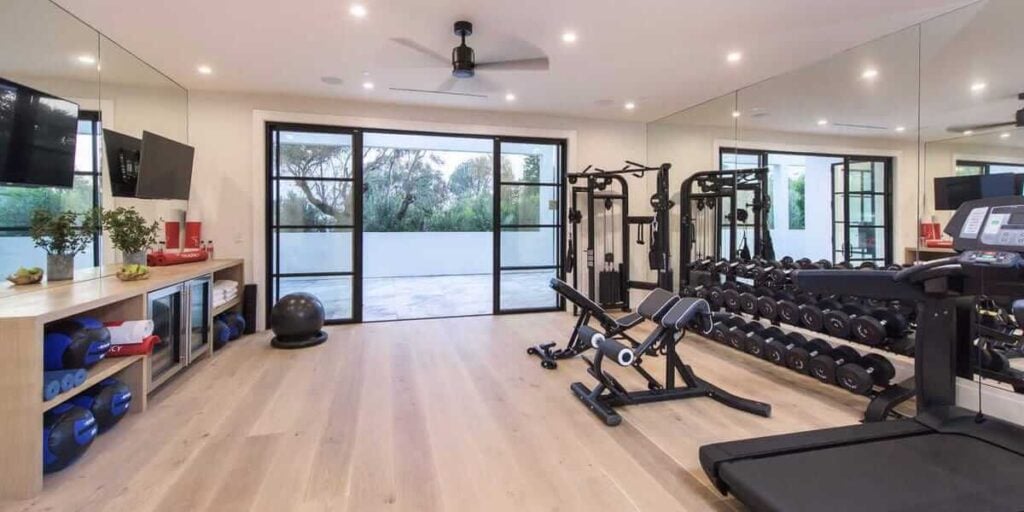If you’re anything like us, we know that you love to work out! There’s nothing like busting out a workout and enjoying that post-workout feeling. It completely re-energizes you and makes you better in every aspect of your life. But a gym membership has its downsides for the elite athlete–it can be far away, cutting into your workout time, membership costs go on indefinitely, and equipment might not be the top notch quality that you need to truly elevate your workouts. Not to mention the plethora of germs from random strangers who may or may not believe in hygiene!
What options do you have? Build a home gym, of course. With your own personal setup, you’ll eliminate the gripes that come with sharing gym space. No more worrying about other people’s germs, dealing with equipment that’s low quality and not tailored to you, and spending your valuable workout time driving to and from the gym!
While the prospect may sound daunting, building a home gym can be a fairly simple (and very rewarding) project. But where do you start? How do you design a home gym? Do aesthetics matter? Not to worry–we’ve got you covered! We’re sharing our best tips and tricks for building a home gym that’s functional, affordable, and tailored to your needs.

Cost of Building a Home Gym
The main reason why dissatisfied gym members never get around to acting on their problems and building a home gym is simple: the cost. We’re not going to sugarcoat it: the process does require more upfront cost than a monthly gym membership. However, over time, we’re convinced that a home gym pays for itself through a better workout experience and fewer ongoing costs.
What are the major costs to keep in mind, and how can you keep them down? One big potential cost is the room remodel. If you’re turning an unfinished basement into a full home gym, you’ll probably need to install electric and even plumbing, decide if you need heating or AC, and install flooring that won’t dent and scratch every time you drop a dumbbell. These costs can add up. In fact, if you’re planning to totally remodel an unfinished room for your home gym, expect to pay over $10k.
To keep these costs down, consider repurposing a finished room, like a spare bedroom or office. You’ll save on an expensive remodel.
The other major investment when building a home gym is equipment. Many first-timers try to cut costs here by buying cheap, generic equipment. While the price tag is smaller up front, long term consequences include frequent replacements and deteriorating (sometimes dangerous!) equipment.
Instead of buying every fitness item imaginable at the lowest price possible, narrow your search to the equipment you use the most. If you’re a weightlifter and hate running, you probably don’t need a treadmill. Instead, choose a few pieces of equipment that you’ll use regularly and invest in high quality, durable products. This way you’ll save money, get the best equipment to help you stay fit, and not invest a small fortune in dumbbells you’ll never use.
Determining the Size of Your Home Gym
When building a home gym, you need to pick a space that’s the right size for your workouts. Obviously a few yoga mats take up a lot less space than a weight machine setup–but how much less? Here are a few handy guidelines to consider when determining the size of your home gym:
- 20 to 50 square feet of space for free weights
- 6 to 10 square feet for a bench
- 30 square feet for treadmills
- 50 to 200 square feet for large, multi-purpose setups like rigs, racks, and machines
If your home gym is a few Dura-Bells, some free weights, and a yoga mat, you can get by with a corner of your home office space. If you plan to have multiple pieces of larger equipment, you should budget for an entire room.
Designing a Home Gym
Functionality is key! When you’re designing your home gym space, consider what you’ll be using it for. Let this guide you as you determine lighting, flooring, and overall design aesthetic. If you’re into high-powered strength workouts with the HeroStrength Battle Rope, you’ll need to give yourself space and avoid decorations that could get knocked over. You’ll also want to consider room features–if you have low ceilings, for instance, you need to find a space that’s not under your fan or light so you don’t worry about damaging them. If you’re into weight training with our Premium Urethane Olympic Plates, you’ll need to consider your floor surface–make sure it can withstand heavy weights.
For your gym aesthetic, consider what frame of mind you’re looking to create. If you’re into pilates, yoga, and other exercises that encourage mindfulness, give yourself a space that reflects peace and calm. If you love high-energy workouts that get your blood pumping, use your space to up the ante with mirrors and bright pops of color.
The bottom line for designing your home gym space? Remember that the advantage of having a home gym is that you get a space entirely designed around your needs. Keep them in mind with every design choice!
Your Home Gym Layout
Your home gym layout should be designed around your unique fitness needs. After all, that’s the beauty of creating your own workout space instead of relying on someone else’s. Keep the equipment you use frequently front and center, and maximize space (especially in a smaller home gym) by investing in storage solutions for your equipment, like our racking systems.
To visualize your layout better, try using a design program like Sketchup to put together an idea of what your gym will look like. You can also find plenty of layout ideas online tailored to the amount of square footage you have to work with.
Workout Room Ideas
What should you keep in mind when building a basement or garage home gym? Here are a few ideas and tips tailored to your space.
Basement Workout Room Ideas
If you’re building a home gym in your basement, you’ll need to keep in mind the limitations of the space: it’s probably less well-lit than the rest of your house, and it probably feels a bit smaller. Fix these issues with good lighting (consider LEDs), and use lots of mirrors to keep the space feeling clean and open!
Garage Gym Ideas
For your garage home gym, consider taking advantage of the space with wall storage. If you plan to train with the garage door up during nice weather, make sure the open door won’t block your lights–or install some LED strips on the inside of the door.





The Ideal Home Gym Starter Kit
While the exact equipment in your home gym depends on your fitness goals, here are some essential pieces that you should make space for:
- Dumbbells. If you love weight training, you might want to invest in a collection, but even if you just do bicep curls occasionally, it’s good to have a few dumbbells available.
- A mat. Many different types of workouts require you to get low, and it’s always a good idea to protect your joints!
- Storage racks. Keep everything tidy and out of the way when you’re not using it.
- An action bag. Versatile and effective, a good punching bag is always a great choice.
If you’re fed up with long drives to the gym, sub-par equipment, and questionable hygiene, a home gym is the perfect choice for you. With some careful planning and quality equipment, you can build the gym of your dreams, right in your own house.
High-quality equipment in your home gym is a must: you’ll get more mileage out of your pieces, and you won’t have to worry about deteriorating plates or unhygienic rubber. Hampton’s fitness products are perfect for your home gym: high quality materials like urethane keep your gym sanitary, and painstaking construction means your equipment will stay in good shape for years. Invest in Hampton Fitness products to take your home gym to the next level!



